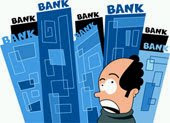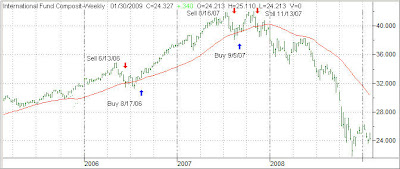 The idea of creating a ‘bad bank’ designed to absorb the toxic assets from banks’ balance sheets is gaining momentum. Of course, we all know that the tax payers ultimately will be fronting the money and will be carrying the burden for generations to come.
The idea of creating a ‘bad bank’ designed to absorb the toxic assets from banks’ balance sheets is gaining momentum. Of course, we all know that the tax payers ultimately will be fronting the money and will be carrying the burden for generations to come.
An alternative would be to nationalize all troubled banks. Dr. Housing Bubble presented some interesting thoughts as to why nationalization would be the lesser of the two evils:
The one thing that is very troubling is the bad bank idea that is now floating out there in dark and gloomy space. Of course, this is a wet dream for the CNBC crowd but is quite possibly the dumbest idea in the world!
Nouriel Roubini and others are calling for a nationalization of banks and as much as it pains me to say, I agree. We either have the choice of being Sweden or having our lost two decades like Japan. If we go with the bad bank model, you can rest assured we are going to have zombie institutions probably until 2020 since there is so much crap on the balance sheet of banks. Take a look at some Real Homes of Genius and see if you are comfortable taking these mortgages onto your balance sheet. The reason the market has been rallying recently is because of this absurd notion. It isn’t because jobs are growing. They are accelerating on the downside. It isn’t because of earnings. Companies are missing left and right. This rally again ignores the silent depression of the vast majority of Americans while catering to the small crony capitalist group who argued for supply side economics and thinks this is a great idea. It isn’t, at least not for 95% of the population.
Now why is nationalization a better use of money? Well first, we are much too far down the road to discuss hands off policies (even though I advocated for this long ago because I knew things like TARP and Ben Bernanke’s nutty work were simply money being flushed down the toilet). First, with nationalization we own the banks flat out. We can then do the following:
-Shareholders get eliminated
-Bondholders get eliminated
-Management gets the boot
-Then and only then, do we separate out the good and bad assets. The good assets we try to sell them off to the market. The bad assets, we assess and slowly process a pricing model and get rid of them. Yet we know since the ownership is now ours that we’ll try to mitigate the loss for taxpayers. Right now with TARP and possibly the bad bank, banks are trying to off load as much of the crap at the highest cost to taxpayers while keeping the caviar assets all for themselves.
-This will get credit moving again because now instead of absurd capital injections, banks will now need to lend money because guess what, we freakin own them and we can decide whether we loan or not!
There is nothing more preposterous than a bad bank. It falls under the SIIV mentality that each progressive bail out gets dumber and dumber. In fact, this notion was what made the TARP fail during its first round. The idea that banks were going to dump the most toxic assets on the backs of taxpayers. Here we are, discussing that damn idea again.
Let us nationalize it and be done with it. Will the market feel pain? Yes! But those who face the most pain will be the banks and Wall Street who deserve it anyway. Wall Street is so disconnected from Main Street that they don’t realize that half our country is already struggling with hard economic times, even before the bust. We already know that they are not looking out for you and if you spend 2 seconds to think about what I just discussed, you’ll understand how horrible a bad bank would be. It is a one-way ticket to a Japan like recession and why are we to expect a different result? Keep in mind that in Japan they had a much higher savings rate which is buffer we do not have. If you think Japan is a picnic think again:
“Over the last few years, temporary employees have gone from being a rarity in Japan to accounting for one-third of the workforce of 67 million. They enjoy far fewer protections than full-time workers — placing their necks squarely on the layoff chopping block.”
We are already seeing the part-time number of workers jump into the stratosphere. Interestingly enough, Japan’s lost decade came after a real estate and stock market bubble. Sound familiar?
So going back to how this interconnects with the paradox of thrift, we are now spending taxpayer money through our government. Not all of it is bad but certainly the TARP and bad bank are horrific ideas. The money we are spending is on the backs of future generations. So much damage has been caused over the last 30 years with acceleration this past decade that we will have years to get this thing back on track. Americans are only now starting to save more (a little) because their credit has been shut off. That is it. That was the end game.
Anyone thinking we’ll be back to the old spending ways when you can get access to your HELOC with one phone call or simply buy a new car every two years is smoking purified financial crack. Those days are gone. The days of zero down NINJA turtle loans on homes are gone. I say good riddance. They have led us to this cliff and have rewarded corruption, greed, and the destruction of our country’s financial stability. I think it is apt to remember what Thomas Jefferson once said:
“If the American people ever allow private banks to control the issue of their currency, first by inflation then by deflation, the banks and the corporations will grow up around them, will deprive the people of all property until their children wake up homeless on the continent their fathers conquered. The issuing power should be taken from the banks and restored to the people, to whom it properly belongs.”
We are in an economic mess that simply does not allow us to look for and pick out elegant and pleasing solutions. Too much money has been wasted already and much will be still flushed down the drain. While bank nationalization may not be the ultimate solution, it’s the best approach at this point to quickly get the ‘bad asset problem’ over with sooner rather than prolonging it forever.
 About a month ago, the beginning of January, a reader contacted me to comment on my Trend Tracking Indexes (TTIs).
About a month ago, the beginning of January, a reader contacted me to comment on my Trend Tracking Indexes (TTIs).




